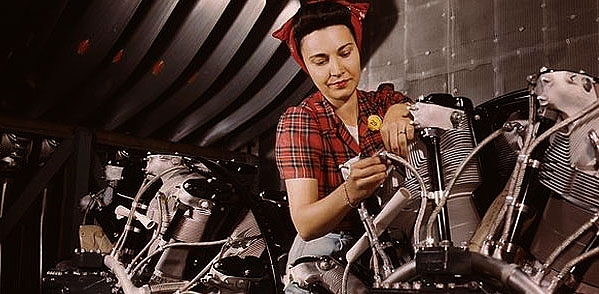 A post-war article concerning the history of U.S. Marine Corps Women's Reserve:
"Organized February 13, 1943 the Women's Reserve was directed by Lt. Colonel Ruth Cheney Streeter (1895 – 1990). Women in the Marine Corps were authorized to hold the same jobs, ranks and pay as Marines."
"From the icy sweeps of Alaska to the tropical Hawaiian Islands, trimly clad girls in the dark blue of the Coast Guard SPARS have served since their organization was founded in 1942 to fill the shore posts of men at sea." "Communications and radio work were an important phase of their duty. Another field in which SPARS were exceptionally active was aviation, with young women in navy blue working in control towers, instructing fledgling fliers via the Link trainer, and parachute riggers...SPARS were also required to familiarize themselves with weapons." "Ranking woman officer is Captain Dorthy C. Stratton (1899 - 2006), Director of the Women's Reserve, appointed on November 24, 1942).
"The Army Nurse during World War II was at work in every quarter of the globe, serving on land, on the sea in hospital ships and in the air, evacuating the wounded by plane. Because of the rugged conditions under which she served, she was trained to use foxholes and to understand gas defense, to purify water in the field and to crawl , heavily equipped, under barbed wire."
By the time VJ-Day rolled around, the Army Nurse Corps was 55,000 strong.
(From Amazon: G.I. Nightingales: The Army Nurse Corps in World War II ) ) "Youngest and largest of the the women's uniformed services, the U.S. Cadet Nurse Corps, has made nursing history in the brief span of it's existence...the corps includes more than 112,000 women between 17 and 35 who enrolled to help meet the emergency demand for nursing service and at the same time prepare themselves for a post-war profession." The attached story of U.S. Navy Nurse Corps and the brave and remarkable women who gallantly served within it's ranks throughout the Second World War is told in this brief article. It documents the selfless service of Navy Nurses who stayed behind in the Philippines to face Japanese captivity rather than desert their patients. "That was typical of the steadfast manner in which Navy Nurses adhered to duty throughout the war, forsaking personal comfort and safety to bring the benefits of their skills to the sick and wounded".
Although the Selective Service agency granted 4,192,000 draft deferments to farmers throughout the course of World War II, the U.S. Department of Agriculture recognized that this number alone would never be enough to harvest the food necessary to feed both the home front and the armed forces. With this shortage in mind, the Women's Land Army was created in 1943 to provide that essential farm labor that proved so vital in winning the war. Between the years 1943 and 1945 millions of American women from various backgrounds rolled up their denim sleeves and got the job done. The attached magazine article is one of the first to tell the tale of this organization, and was printed at a time when there were only 60,000 women in the field.< |
MORE ARTICLES >>> PAGE: * 1 * 2 * 3 * 4 * |
|